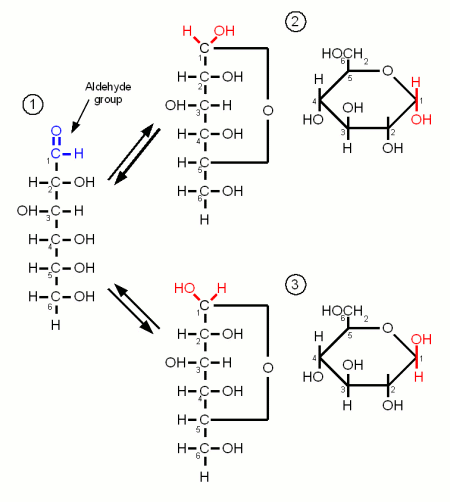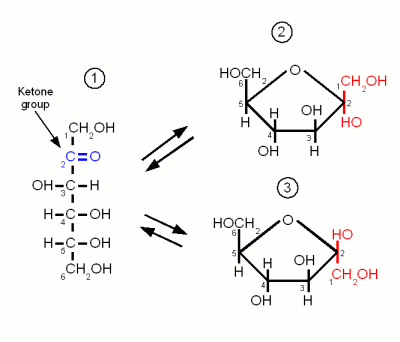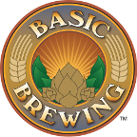Carbohydrates
Carbohydrates are organic molecules that contain carbon, oxygen and hydrogen and are the most abundant organic compounds in nature. They serve as forms of energy source and storage and structural components for plants and some animals [Champe]. They have the basic formula (CH2O)n hence the name Carbohydrate or hydrate of carbon. Important carbohydrates in brewing are simple sugars (e.g. glucose, fructose), complex sugars (e.g. maltose, sucrose, maltotriose), dextrins and starches. But glucans, pectins and gums are also carbohydrates.
The following sections give insight into the structure of carbohydrates important in brewing. Some are more and others (e.g. lactose and sucrose) are less important in mashing but may be used at other places in the brewing process.
Contents
Monosaccharides
Monosaccharides are the simples carbohydrates and have the basic formula CnH2nOn. They are the building blocks of the more complex carbohydrates. The monosaccharides important to brewing, Glucose, Galactose and Fructose, are hexoses which contain 6 carbon atoms. They differ either in their carbonyl group or the orientation of the OH and H groups along the carbon chain. The carbonyl group is the group that contains the oxygen that is linked twice to a carbon atom. Either to the same carbon atom or tow different atoms from the same chain. Glucose and Galactose are adelose sugars and have an aldehyde group (Figures 1 and 3) as their carbonyl group and Fructrose is a ketose sugar and has a Ketone group (Figure 2).
Monosaccharides may exist in a open chain or in a ring configuration. But for monosaccharides with more than five carbons only less than one percent of the molecules will be in the open chain configuration. The rest is in the ring configuration. The rings are formed by the oxygen atom from the carbonyl group binding to another carbon atom of the chain.
By convetion the carbon atoms are numbered such that the highest numbered carbon is farthest away from the carbonyl (aldehyde or ketone) group.
Glucose

Glucose is by far the most important monosaccride in brewing. It is the building block for starch and thus produced during mashing. When the oxygen of the aldehyde group also binds to carbon atom 5 the molecule forms the ring typical for carbohydrates. The resulting molecule is called glucopyranose and depending on the orientation of the OH group on carbon 1 the molecule may be in the α or the β configuration. The difference is subtle but becomes important later when the glucose binds to other molecules to form more complex sugars. At this point α vs. β configuration becomes permanent and makes the difference between being convertible by mash and yeast enzymes or not.
But as long as the glucose molecule on its own both configurations coexist in an equilibrium and can change between the configurations by changing back to the open chain and back to the ring in the other configuration
Fructose
Like glucose, fructose is also a hexose sugar but unlike glucose it is a ketose sugar because it has a ketone group as its carbonyl group. This group contains carbon 2 (instead of the carbon 1 that is included in glucose's aldehyde group) and as a result the ring that is formed by the oxygen atom of that group binding to carbon 5 has a pentagon shape in the Hanworth projection (Figure 2).
Fructose has no importance to mashing. It is only present in malt in very small amounts. It may come into beer in substantial amounts through the addition of fruit juices, sucrose or invert sugar.
Galactose
Galactose is of no importance to mashing as it is neither present in malt nor the produced wort. It's only importance to brewing is through the addition of lactose, which is made of glucose and galactose, as a sweet by unfermentable sugar in certain beer styles (e.g. milk stouts). Like glucose it is an adelose sugar but it differs from glucose in the orientation of the OH group on carbon 4.
Disaccharides
The glycosidic bond
A glycosidic bond is formed when the carbonyl group of one monosaccharide reacts with a hydroxyl (OH) group of another molecule and water is eliminated [Vaclavik]. It is the "glue" that holds together monosaccharides to form more complex carbohydrates. When a glycosidic bond is formed the molecule with the carbonyl group that is involved in the bond gets locked into the α or β configuration. Enzyme can distinguish between these two types of bonds and that's why it is important to note the type of a bond. α links hold together fermentable carbohydrates (disaccharides and trisacharides) or carbohydates that can be made fermentable in mashing (dextrins and starches) while β links are the links that hold together structural malt components (cellulose, β-glucans). Another convention is to note which carbon atoms are involved in the bond. A α-1,4 (or α(1→4)) glycosidic bond is between carbon 1 (carbonyl group) of one molecule and carbon 4 of the other molecule.
Maltose and Cellobiose
Both Maltose and Cellobiose consist of 2 glucose molecules linked. In maltose they are liked with an α(1→4) link while in Cellibiose they are linked with a β(1→4) link. The result is that maltose can be fermented by yeast while cellibose cannot.
Maltose is the most abundant sugar in wort and hence very important in brewing. It is created by the enzymatic hydrolization (degradation) of starch. Cellobiose is the building block of cellulose and has no importance in brewing as it is not degraded by mash enzymes.
Sucrose
Lactose
References
- [Valclavik] Vickie A. Valclavik, Elizabeth W. Christian, Essentials of Food Science, Third Edition, Springer
- [Champe] Pamela C, Champe, Richard A. Harvey, Denise R. Ferrier, Biochemistry, Lippincott's Illustrated Reviews
- types of sugar
- monosaccharides glucose, fructose, galctose
- disacchatrides maltose, succrose, lactose
- reducing/non reducing sugars
- where it is found
- glucose and 1-4/1-6 branches
- amylose
- amylopectin
- starch granule structure


